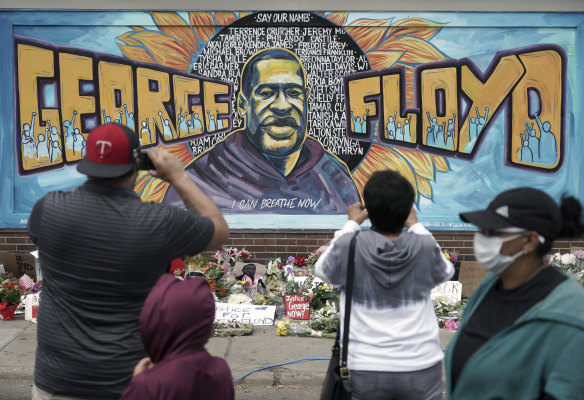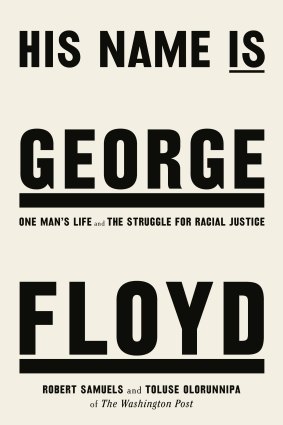By Maxine Beneba Clarke
The whole world saw George Perry Floyd Jnr murdered on a street in Minneapolis, Minnesota, under the knee of former police officer and now convicted murderer Derek Chauvin. The footage that captured the solidly built 193 centimetre Black man being slowly asphyxiated in broad daylight, to the horrified cries of bystanders, was played by the media on macabre loop. We heard him, this giant of a man, crying out desperately for his mama. He screamed, “You’re going to kill me.” He cried, “Tell my kids I love them.” He pleaded,“I can’t breathe.”
In those final moments. George Perry Floyd Jnr knew exactly what was happening, because George Floyd knew what it was to be a Black man in the United States of America.

People gather at a memorial mural outside the store where George Floyd died.Credit: Brian Peterson
His Name is George Floyd is the story of how Floyd ended up on that particular pavement, on that particular day – May 25, 2020. It is also a story about the fallacy of the American Dream, the absurdity of the meritocracy myth, and how a deeply rooted white supremacist ideology was a snarling hound at Floyd’s heels not only the moment he came into the world, but generations before he even existed as a dotted quaver in his musician father’s eye.
His Name is George Floyd takes more than 400 interviews with Floyd’s siblings, aunts, uncles, cousins, cellmates, lovers, roommates, coaches, neighbours and teachers, and weaves them into a complex, compelling and lyrical biography. Authors Robert Samuels and Toluse Olorunnipa, both experienced Black journalists of acclaim, know intimately the instinct that was Floyd folding his body to enter a room: the origami-like inward-curving of his shoulders, as he smiled and offered a handshake to anyone who would take it in an effort to diffuse a fear as old as colonisation itself.
But a portrait such as this – nuanced, bittersweet, painstakingly constructed - eventuated not only from the personal lens of the authors and their meticulous historical research, but from extraordinary forthrightness from those who knew Floyd best. The book, at its core, is an act of love, and of community. Woven through its pages is a sweeping, heartfelt in memoriam that simultaneously celebrates Floyd’s life and indicts the relentless systematic oppression waiting for him at every turn.

His Name is George Floyd by Robert Samuels and Toluse Olorunnipa
Perhaps the book’s greatest triumph is its refusal to bow to a single didactic truth. Floyd is lovingly resurrected with all the flaws he himself readily acknowledged. He was a family oriented man who did not always do the very best by family. He loved his neighbourhood, and at times, knew he had to leave it to survive. He was targeted, stalked and set up by law enforcement, and sometimes found himself genuinely on the wrong side of the law. On his best days, he was optimistic and full of hope for a better future, and on his darkest he was consumed by helplessness, desperation and despair as another job, another dream, another childhood friend, drew final breath. It is this unashamedly complex humanity that sings through the pages of His Name is George Floyd.
That it is both impossible to pinpoint the moment Floyd’s fate was sealed, and easy to identify pivotal events in the days, decades and centuries past, where basic human decency could have changed the course of Floyd’s life, is the aching reality of this story. There was the systematic underfunding of public schools in predominantly Black districts post-segregation, and exams such as the Texas Assessment of Academic Skills, ruled in 1999 to be racially biased against Black and Latinx students, but nevertheless continued as a testing tool across the state. This testing regime served to exclude Floyd from progression on the sports field – one of a handful of pathways available to poor Black teens.
There was that second time Floyd was arrested, when he complained of depression, of hearing the voices of his dead friends, yet was sentenced to eight months in a state jail without treatment. There was the land Floyd’s great-great-grandfather Hillery Thomas Stewart, a man born into slavery, finally managed to amass, after 30 years of working as a free man. What followed were a series of transactions – emblematic of Black land loss due to fraudulent tax actions – through which the family’s land was taken from them. Floyd’s grandparents, the next generation down, were sharecroppers cheated by shifty white landowners out of the upward mobility their lucrative tobacco crops might have afforded them. Injustice after injustice conspired against Floyd’s ancestors, right down the bloodline to him.
By the time His Name is George Floyd has reached its horrifying crescendo some two-thirds of the way through the narrative, we are standing on the sidewalk, screaming at Chauvin. Please officer, get the hell off his neck! Get off him. That’s George, from Third Ward, whose mama Larcenia used to cook soul food for hungry folk in the neighbourhood. Get off him! That’s George Perry Floyd Jnr, who used to play ball down at Jack Yates Senior High. George, who wanted to rap his way out of the neighbourhood!
We know, by the time George Floyd is in that restraint hold on the pavement, that 10 years earlier, a 28-year-old Black man named David Cornelius Smith was wrestled to the ground, handcuffed, and forced to lie on his stomach. We know Smith cried for help, then fell silent. We know the city of Minneapolis settled with Smith’s family after his death, but chose not to restrict such holds. We know, most hauntingly, that four years later, a veteran street cop named Derek Chauvin attended a training session to learn how to restrain suspects in much the same manner. The authors have cleverly and painstakingly plotted us to this moment.
Floyd’s death, the eventual arrests of the officers involved, and their respective trials unfold to a worldwide outpouring of anger, grief and solidarity, and a renewed resolve to initiate change. His Name is George Floyd is an absolute triumph – truly a book not to be missed. Though it sits comfortably alongside contemporary Black classics such as Ta-Nehisi Coates’ Between the World and Me and Kiese Laymon’s Heavy, it is also resonant of civil rights era non-fiction texts such as James Baldwin’s The Fire Next Time, and If They Come in the Morning: Voices of Resistance.
One hopes, some day, these narratives serve more as historical record than contemporary updates on a story as old as the first slave ship to drop anchor on the African coast.
His Name Is George Floyd: One Man’s Life, and the Struggle for Racial Justice by Robert Samuels and Toluse Olorunnipa is published by Penguin, $35.
The Booklist is a weekly newsletter for book lovers from books editor Jason Steger. Get it delivered every Friday.